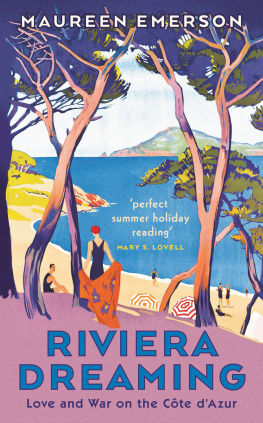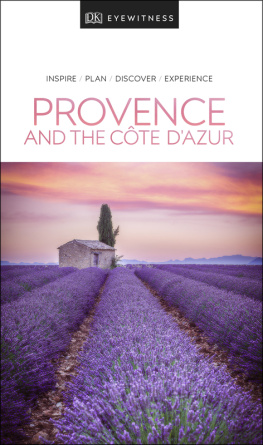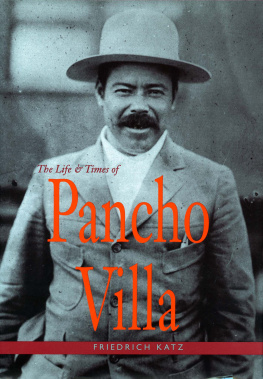
Maureen Emerson lived in Provence for 20 years, where she worked as a local co-ordinator for CBS and NBC at media festivals in Cannes. During her years in Provence, Maureen became enthralled with the stories of those expatriates who lived on the Riviera in the 1920s and 1930s and how World War II affected their lives. Her first book on the Riviera, Escape to Provence, was published in 2008.
A compelling account of life on the French Riviera from 1920 onwards, Riviera Dreaming charts the work of renowned architect of the Art Deco era, Barry Dierks. This well-written book is packed with history and glamorous insider stories of the rich and famous, contrasted with the hardships of local residents living under German occupation during World War II. Meticulously researched by long-term resident Maureen Emerson it makes a riveting read; perfect summer holiday reading. Bet you wont be able to put it down.
Mary S. Lovell, author of The Mitford Girls
Through the work of Barry Dierks and Eric Sawyer, as architect and gardener, Maureen Emerson has created a fascinating account of the South of France in times of glorious peace and hideous war, telling the stories of those who made their homes there. She evokes a particular generation in this wonderful book.
Hugo Vickers

Published in 2018 by
I.B.Tauris & Co. Ltd
London New York
www.ibtauris.com
Copyright 2018 Maureen Emerson
The right of Maureen Emerson to be identified as the author of this work has been asserted by the author in accordance with the Copyright, Designs and Patents Act 1988.
All rights reserved. Except for brief quotations in a review, this book, or any part thereof, may not be reproduced, stored in or introduced into a retrieval system, or transmitted, in any form or by any means, electronic, mechanical, photocopying, recording or otherwise, without the prior written permission of the publisher.
Every attempt has been made to gain permission for the use of the images in this book. Any omissions will be rectified in future editions.
References to websites were correct at the time of writing.
ISBN: 978 1 78831 162 5
eISBN: 978 1 78672 338 3
ePDF: 978 1 78673 338 2
A full CIP record for this book is available from the British Library
A full CIP record is available from the Library of Congress
Library of Congress Catalog Card Number: available
Typeset by Free Range Book Design & Production Limited
To Andrew Merton, without whom this book would not have seen the light of day
Contents
List of Plates
Le Trident, with the trident shaped rocks below. Martin Scott.
Elegant Barry. Courtesy of the archives of Andrew Merton.
Barry and Eric in their study. Courtesy of the archives of Andrew Merton.
Barry and friends relaxing. Courtesy of the archives of Andrew Merton.
The upstairs corridor at Le Trident, with its succession of arches. Courtesy of the archives of Andrew Merton.
Somerset Maugham in a rooftop folly, built by the previous owner of La Mauresque. Courtesy of the Edward Quinn Archive AG.
Maugham and Alan Searle dining in the Moorish patio at La Mauresque. Courtesy of the Lebrecht Music and Arts Photo Library.
Maugham on the staircase at La Mauresque. Courtesy of the Edward Quinn Archive AG.
Freddy McEvoy, Beatrices fourth and racy husband. Public domain.
The Casa Estella from Millionaires Bay on the Cap dAntibes. Rgion Provence-Alpes-Cte dAzur-Inventaire gnral-G. Roucaute.
Beatrice Cartwright painted by Reynaldo Luza. Watercolour 1943. Courtesy of Linda Hackett.
Maxine Elliott in 1908, breaking the ground for the Maxine Elliott theatre in New York. Public domain.
An aerial view of Le Roc and its Mendelsohn-style pool house. Courtesy of the Houghton Hall archives.
The spectacular Chteau de lHorizon with its famous slide, beloved of Winston Churchill. Courtesy of les Archives de la Ville de Cannes.
Lord and Lady Cholmondeley of Le Roc, luxuriating in sun and sea. Courtesy of the Houghton Hall archives.
The sinuous lines of the Villa Aujourdhui on the Cap dAntibes. By permission of the current owner.
Eric Sawyer (left) and a fellow driver for the Cannes Anglo-American ambulance service, 1940. Courtesy of the archives of Andrew Merton.
Isabel Pell and her dog Heine under house arrest at Le Moulin, 1943. Courtesy of the Association Culturelle du Pays Pugetois.
Jack Warner with two of his most feisty stars: Bette Davis (left) and Joan Crawford (right). Photo by Hulton Archive/Getty Images.
Acknowledgements
I am indebted to Andrew Merton, great-nephew of Eric and godson of both Eric and Barry, without whom this book would not have seen the light of day; Hugo Vickers, for suggesting I write the story of Barry Dierks, and who has stayed in three of his houses. Also for his encouragement and generosity; Peter Riley, brilliant webmaster, whose expertise and friendship I treasure; my daughter Christina Emerson who has guided me so patiently from start to finish, and particularly on architectural detail; Jill Shepperd, who undertook valuable research, which included photography, delving into archives and scrambling over rocks and up hillsides; Malcolm Dunstan, great-nephew of Eric Dunstan, who gave me carte blanche for drawing on the latters private diaries; Suzanne and Philip Kenny, who shared the dramatic story of Emmanuel Martinez and his hotel; Sebastian and Olivier Drobert, who knew both Barry and Eric, and their research beyond the call of friendship; Franois de Guiringaud, who knows all about Melpomene; John Halsey, for his valued reminiscences of life on the Riviera and tales of his friendship with the two Erics; and Patience Marriott, who knew so many over the years.
Sincere appreciation goes to the following for so much help in so many ways: Richard Chapman; Mary S. Lovell; James Buchanan-Jardine; Victor Werny of Puget Thniers; Yves Pourcher; Jahnene Green; Benjamin Lafore; Keith Jane; Eve Pell; Fredrik Lilloe of Knight Frank; Joanna Millar; Linda Hackett; Ajay Kamalakaran; Dr Robin Darwall-Smith of Magdalen College, Oxford; Wolfgang Frei, Edward Quinn Archive; Daria Wallace, Lebrecht Photo Library; Desiree Butterfield-Nagy, University of Maine.
If I have omitted to include others to whom I am indebted, please forgive me.
PART ONE
Lights and Music
The English Visitor calls the entire coast from Marseilles to Genoa the Riviera; but the French distinguish their portion as the Cte dAzur, and the Italians distinguish theirs as The Riviera di Ponente.
S. Baring-Gould, A Book of the Riviera
Le Trident 1925
Barry and Eric
How This Coast Smells of Riches!
Laurence Binyon, For Dauntless France
So wrote the American Jane de Glehn, wife of the English artist Wilfred de Glehn, when she first set foot on the Riviera after the 1918 Armistice of World War I.
Europe had been ablaze and the fires had gone out. Now the Riviera began slowly to return to a semblance of its former self. During the war the area had become a vast hospital for the wounded, but gradually the old life of catering to privileged visitors returned, although in an increasingly different form. Suddenly everything seemed possible. Moving pictures, wonderfully designed automobiles, new music, liberating fashions were all exhilarating. By the early twenties the towns along the coast were alive with a fevered post-war excitement. Among the palm trees, oleander and bougainvillea the belle poque, with its ornate architecture and amply dressed winter visitors, was over. The owners of the great villas of Victorian times were getting older and entering a new era which would transform their way of life in resorts where they had held sway for so long. As a result of the Bolshevik revolution the Russian nobility had either disappeared from the coast, leaving their beautiful onion-domed churches as proof of passage or, now being poor, become taxi drivers, hotel managers and servants. Their sumptuous villas were converted into hotels or taken over by other, richer expatriates. As the trauma of the war faded, crowds of international socialites, both old and new, came to luxuriate in the beauty of the coast.
Next page










